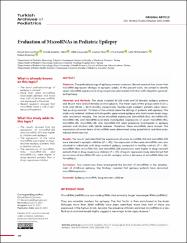| dc.contributor.author | Çarman, Kürşat Bora | |
| dc.contributor.author | Gazeteci Tekin, Hande | |
| dc.contributor.author | Çavuşoğlu, Dilek | |
| dc.contributor.author | Yarar, Coşkun | |
| dc.contributor.author | Kaplan, Emre | |
| dc.contributor.author | Karademir, Cefa Nil | |
| dc.contributor.author | Arslantaş, Didem | |
| dc.date.accessioned | 2023-09-29T08:57:18Z | |
| dc.date.available | 2023-09-29T08:57:18Z | |
| dc.date.issued | 2023 | en_US |
| dc.identifier.citation | Çarman, K. B., Tekin, H. G., Çavuşoğlu, D., Yarar, C., Kaplan, E., Karademir, C. N., & Arslantaş, D. (2023). Evaluation of MicroRNAs in Pediatric Epilepsy. Turkish Archives of Pediatrics, 58(4), 429-435. | en_US |
| dc.identifier.issn | 2757-6256 | |
| dc.identifier.uri | https://dx.doi.org/10.5152/TurkArchPediatr.2023.22320. | |
| dc.identifier.uri | https://hdl.handle.net/20.500.12933/1616 | |
| dc.description.abstract | Objective: The pathophysiology of epilepsy remains unknown. Recent research has shown that microRNA expression changes in epileptic adults. In the present work, we aimed to identify serum microRNA expression in drug-responsive and resistant children with idiopathic general- ized epilepsy.
Materials and methods: The study included 43 (20 male and 23 female) epilepsy patients and 66 (43 male and 23 female) control subjects. The mean ages of the groups were 113.41 ± 61.83 and 105.46 ± 62.31 months, respectively. Twenty-eight epileptic patients were classi- fied as drug resistant. Thirteen of the controls were the siblings of patients with epilepsy. The study only included children with idiopathic generalized epilepsy who had normal brain mag- netic resonance imaging. The serum microRNA expressions (microRNA-181a, microRNA-155, microRNA-146, and microRNA-223) were investigated. Expressions of serum microRNA-181a, microRNA-155, microRNA-146, and microRNA-223 were previously investigated in epilepsy patients and children with febrile seizures. Therefore, these microRNAs were chosen. The expressions of serum levels of microRNAs were determined using quantitative real-time poly- merase chain reaction.
Results: The results indicated that the expressions of serum microRNA-155 and microRNA-223 were elevated in epileptic children (P < .05). The expression of the same microRNAs was also elevated in individuals with drug-resistant epilepsy compared to healthy controls (P < .05). microRNA-146a, microRNA-155, and microRNA-223 expressions were higher in drug-resistant patients than in drug-responsive children (P < .05). A logistic regression study determined that an increase of microRNA-155 was a risk for epilepsy, while a decrease of microRNA-146a risk for epilepsy.
Conclusion: Few researchers have investigated the function of microRNAs in the develop- ment of childhood epilepsy. Our findings revealed that epilepsy patients have abnormal microRNAexpression. | en_US |
| dc.language.iso | eng | en_US |
| dc.publisher | Turkey : AVES | en_US |
| dc.relation.isversionof | 10.5152/TurkArchPediatr.2023.22320. | en_US |
| dc.rights | info:eu-repo/semantics/openAccess | en_US |
| dc.subject | Epilepsy | en_US |
| dc.subject | microRNA | en_US |
| dc.subject | Drug Resistant | en_US |
| dc.subject | Children | en_US |
| dc.title | Evaluation of MicroRNAs in Pediatric Epilepsy | en_US |
| dc.type | article | en_US |
| dc.authorid | 0000-0003-4924-5300 | en_US |
| dc.department | AFSÜ | en_US |
| dc.contributor.institutionauthor | Çavuşoğlu, Dilek | |
| dc.identifier.volume | 58 | en_US |
| dc.identifier.issue | 4 | en_US |
| dc.identifier.startpage | 429 | en_US |
| dc.identifier.endpage | 435 | en_US |
| dc.relation.journal | Turkish archives of pediatrics | en_US |
| dc.relation.publicationcategory | Makale - Uluslararası Hakemli Dergi - Kurum Öğretim Elemanı | en_US |
















